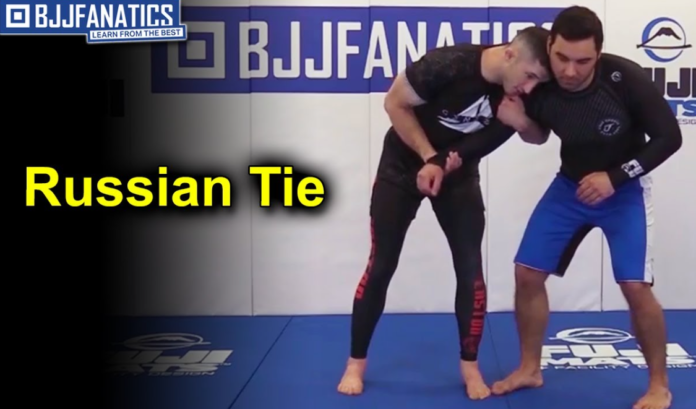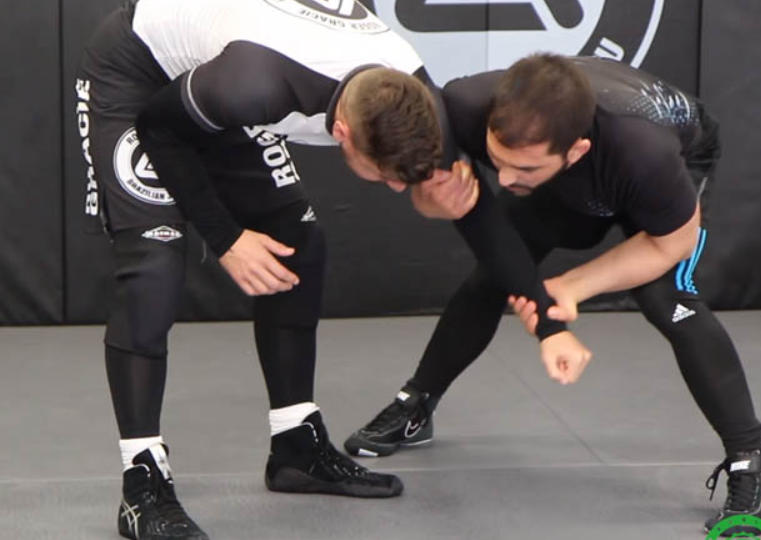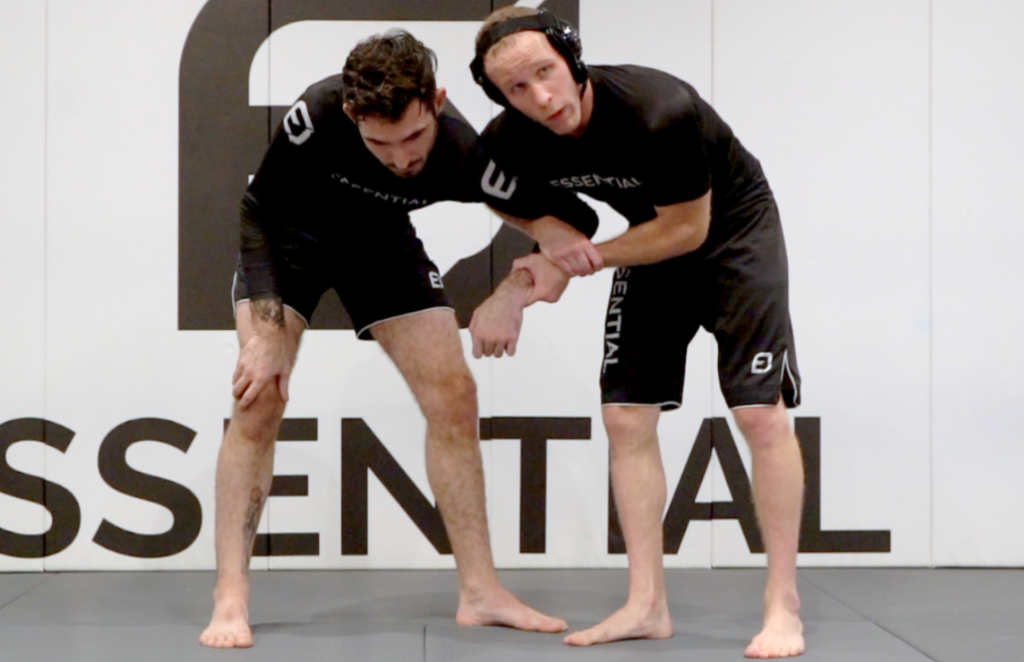
If you are looking for a powerful and versatile grip that can help you dominate your opponent on the feet and set up various takedowns and submissions, you need to learn the Russian tie.
The Russian tie is a position that every BJJ practitioner should master, as it can give you an edge over your competitors in both Gi and No-Gi grappling. In this article, we will explain what the Russian tie is, how to set it up and execute it in different scenarios, and some common mistakes to avoid.
What is the Russian Tie?
The Russian tie, also known as the Russian 2-on-1, is a control position where you grab your opponent’s wrist with one hand and their shoulder or elbow with the other hand. By doing this, you isolate their arm and prevent them from attacking you with it. You also create leverage and angles to manipulate their balance and posture, opening up opportunities for takedowns and submissions.
The Russian tie can be used in both Gi and No-Gi grappling, but the grips and details may vary slightly depending on the scenario. In No-Gi, you typically stand side-by-side with your opponent, facing in the same direction. You grab their wrist with your near hand and reach over their shoulder with your far hand. You then twist your body and pull their arm across your chest, securing the Russian tie position by lifting their wrist and dropping your shoulder on top of theirs.
In Gi Jiu-Jitsu, you usually stand in front of your opponent and establish a cross grip on their sleeve. Your right hand goes to their right wrist/sleeve, and your left hand goes over their shoulder and grabs the back of their collar. You then pull their arm across your body and tuck your elbow close to your torso, while using the collar grip to control their head.
How to Use the Russian Tie for Takedowns
Once you have established the Russian tie, you have several options for taking your opponent down. Some of the most common and effective takedowns from the Russian tie are:
- Russian Tie Throw(s)
This is a spectacular and explosive takedown that involves rolling under your opponent with your head between their legs. You use the momentum of the roll to flip them over your body and land in side control.
To perform this takedown, you need to lower your level and place your head in front of their lead leg. You then dive under them while keeping a tight grip on their arm via a slightly modified Russian tie. Namely, you want to establish a Kimura grip (figure four grip) so that you stay attached and in complete control as you roll under.
- Russian Tie Trip
This is a simple and quick takedown that involves pulling your opponent’s arm across your body to get them off balance.
You then step behind their leg and trip them down or take their back.
To perform this takedown, you need to pull their arm across your chest while stepping to the side with your near leg. You then put all your weight behind the Russian tie control, pressing your chest to the triceps. As the opponents try to posture up, you use their momentum to trip them, either by hooking the near leg with your leg, or tripping them by placing your instep behind their back leg.
- Russian Tie Single Leg Takedown
This is a classic wrestling takedown that involves grabbing your opponent’s leg and driving them down. You can set single leg takedowns from the Russian tie by creating an optimal angle and clearing their arm.
To perform this takedown, you need to step to the side with your near leg while pulling their arm across your body. You then release their wrist (or sleeve) and grab their near side leg behind the knee with your near hand. You then drive forward while lifting their leg and pushing them down with your other grip or finish with any variation of the single leg that you prefer.
How to Use the Russian Tie for Submissions
The Russian tie can also be used to set up various submissions. BJJ might be the king of ground fighting martial arts, but you still need moes like the Russian Tie to get to the ground. That said, you can follow up on your 2-on-1 efforts with some very effective submissions from the like:
- D’arce Choke
The D’arce choke involves wrapping your arm around your opponent’s neck and shoulder from a front headlock position and locking it with your other arm behind the opponent’s neck. You then squeeze and twist to finish the choke.
To get the D’arce off you need to transition from the Russian tie to a front headlock position if you haven’t landed in top side control after finishing a throw or takedown.
From the front headlock, you’ll need to switch the arm controlling their wrist to a collar tie to ensure you tilt them to their side (most often by utilizing a Nelson variation). Once the opponent is on their side, with their top arm trapped by your weight, you can slide the arm controlling the upper arm across their neck to get the D’arce position.
- Kimura
This is a variation of the kimura lock that involves twisting your opponent’s arm behind their back and applying pressure on their shoulder. You can perform this submission on the feet or on the ground.
To finish the Kimura, you need to transition from the Russian tie to a figure four grip by switching the hand you’re using to hold their wrist. Trapping their upper arm gives you more than enough time to achieve this. after you have the grip, you can finish the Kimura any way you want.
- Armbar
This is a variation of the armbar that involves trapping your opponent’s arm between your legs and extending it to hyperextend their elbow.
The transition from the Russian tie to an armbar position needs to be fast as you; ‘re moving your weight away from the opponent in order to get to an armbar position. Think of Mighty Mouse’s legendary suplex armbar in the UFc – that’s the kind of transitioning speed ou need to pull this one off.
Common Mistakes to Avoid
The Russian tie is a powerful and versatile position, but it also requires some skill and attention to detail. Here are some common mistakes to avoid when using the Russian tie for the purposes of BJJ:
- Not controlling the posture: The head is the key to controlling your opponent’s posture and balance. If you let them lift their head up, they can escape or counter your attacks. While you’re not gripping the head directly, you’re still affecting posture via the shoulder of the arm you’re controlling with the 2-on-1. Remember to keep their posture broken (folded) at all times.
- Missing angles: The Russian tie works best when you create angles and move around your opponent. If you stay in front of them, they can defend or attack more easily. You need to use your footwork and body movement to create angles and openings for your attacks.
- Not being aggressive: The Russian tie is a position that requires aggression and pressure. If you are passive or hesitant, you will lose the advantage and give your opponent time to recover or counter. You need to be aggressive and decisive with your attacks, using speed and explosiveness to catch them off guard.
Conclusion
The Russian tie is a position that every Brazilian Jiu-Jitsu practitioner should learn and master. It can help you control your opponent, set up takedowns and submissions, and dominate the stand-up game. Whether you practice BJJ in Gi or No-Gi, or any grappling martial arts for that matter, the Russian tie can give you an edge over your competitors. Try it out and see for yourself how effective it is.
Also, make sure to check out this previous article we have on single leg takedowns:
How to Make the Single Leg Takedown Work For BJJ, MMA and Wrestling Athletes


![Darce Choke Encyclopedia – Origins, Mechanics and Variations [2025] BJJ, choke, Brabo, BJJ Darce Choke, D'arce Choke, Darce BJJ Choke](https://bjj-world.com/wp-content/uploads/2017/11/JungPoirierLeeYahoo-218x150.jpg)











![Closet Closed Guard Craig Jones DVD Review [2025] Closet Closed Guard Craig Jones DVD Review](https://bjj-world.com/wp-content/uploads/2025/03/closet-closed-guard-craig-jones-dvd-review-218x150.png)
![Xanadu Back Takes Levi Jones-Leary DVD Review [2025] Xanadu Back Takes Levi Jones-Leary DVD Review](https://bjj-world.com/wp-content/uploads/2025/03/xanadu-back-takes-levi-jones-leary-dvd-review-218x150.png)

![No-Gi Grapplers Guide To Front Headlock Joel Bane DVD Review [2025] No-Gi Grapplers Guide To Front Headlock Joel Bane DVD Review](https://bjj-world.com/wp-content/uploads/2025/03/no-gi-front-headlock-joel-bane-dvd-review-218x150.png)

![Get Off My Legs Gringo Craig Jones DVD Review [2025] Get Off My Legs Gringo Craig Jones DVD Review](https://bjj-world.com/wp-content/uploads/2025/03/get-off-my-legs-gringo-craig-jones-dvd-review-218x150.png)
![Feet Finder Foot Sweeps Christian Ozbek DVD Review [2024] Feet Finder Foot Sweeps Christian Ozbek DVD Review](https://bjj-world.com/wp-content/uploads/2024/09/feet-finder-foot-sweeps-christian-ozbek-dvd-review-100x70.png)
![Leg Lock Entries Helena Crevar DVD Review [2025] Leg Lock Entries Helena Crevar DVD Review](https://bjj-world.com/wp-content/uploads/2025/03/leg-lock-entries-helena-crevar-dvd-review-100x70.png)
![Henry Akins Black Hole No-Gi Closed Guard DVD Review [2024] Henry Akins Black Hole No-Gi Closed Guard DVD Review](https://bjj-world.com/wp-content/uploads/2024/09/henry-akins-black-hole-no-gi-closed-guard-dvd-review-100x70.png)
![The Buchecha Gi Takedown System DVD Review [2025] The Buchecha Gi Takedown System DVD Review](https://bjj-world.com/wp-content/uploads/2025/01/buchecha-gi-takedown-system-dvd-review-100x70.png)


![Essential Shin To Shin System Shawn Williams DVD Review [2025] Essential Shin To Shin System Shawn Williams DVD Review](https://bjj-world.com/wp-content/uploads/2025/01/shin-to-shin-system-shawn-williams-dvd-review-100x70.png)

![No-Gi Open Guard K-Guard Lachlan Giles DVD Review [2024] No-Gi Open Guard K-Guard Lachlan Giles DVD Review](https://bjj-world.com/wp-content/uploads/2024/12/no-gi-open-guard-k-guard-lachlan-giles-dvd-review-100x70.png)
![Bricks Kesa Gatame System Jeremy Brick DVD Review [2025] Bricks Kesa Gatame System Jeremy Brick DVD Review](https://bjj-world.com/wp-content/uploads/2025/02/bricks-kesa-gatame-system-jeremy-brick-dvd-review-100x70.png)
![Full Guard Formula James Booth DVD Review [2025] Full Guard Formula James Booth DVD Review](https://bjj-world.com/wp-content/uploads/2025/02/full-guard-formula-james-booth-dvd-review-100x70.png)
![Countering Triangles And Omoplatas Adam Mazin DVD Review [2024] Countering Triangles And Omoplatas Adam Mazin DVD Review](https://bjj-world.com/wp-content/uploads/2024/10/countering-triangles-and-omoplatas-adam-mazin-dvd-REVIEW-100x70.png)
![Understanding The Distance On Top Gui Mendes DVD Review [2024] Understanding The Distance On Top Gui Mendes DVD Review](https://bjj-world.com/wp-content/uploads/2024/10/distance-on-top-gui-mendes-dvd-review-100x70.png)


![The Empty Half Guard Michael Currier DVD Review [2025] The Empty Half Guard Michael Currier DVD Review](https://bjj-world.com/wp-content/uploads/2025/03/empty-half-guard-michael-currier-dvd-review-100x70.png)
![Highlight Hip Throws Christian Ozbek DVD Review [2025] Highlight Hip Throws Christian Ozbek DVD Review](https://bjj-world.com/wp-content/uploads/2025/01/highlight-hip-throws-christian-ozbek-dvd-review-100x70.png)






![Total Domination Top Control Mariusz Domasat DVD Review [2024] Total Domination Top Control Mariusz Domasat DVD Review](https://bjj-world.com/wp-content/uploads/2024/09/domination-top-control-mariusz-domasat-dvd-review-100x70.png)
![Jeff Higgs Self Defense Guard BJJ DVD Review [2024] Jeff Higgs Self Defense Guard BJJ DVD Review](https://bjj-world.com/wp-content/uploads/2024/09/jeff-higgs-self-defense-guard-bjj-dvd-review-100x70.png)

![Master The Move Anaconda Strangle John Danaher DVD Review [2025] Master The Move Anaconda Strangle John Danaher DVD Review](https://bjj-world.com/wp-content/uploads/2025/02/anaconda-strangle-john-danaher-dvd-review-100x70.png)
![Reverse Arm Bar System Andrew Kerfoot DVD Review [2024] Reverse Arm Bar System Andrew Kerfoot DVD Review](https://bjj-world.com/wp-content/uploads/2024/10/reverse-arm-bar-system-andrew-kerfoot-dvd-review-100x70.png)
![360 Degrees Guard Retention Thiago Abud DVD Review [2024] 360 Degrees Guard Retention Thiago Abud DVD Review](https://bjj-world.com/wp-content/uploads/2024/10/360-degrees-guard-retention-thiago-abud-dvd-review-100x70.png)